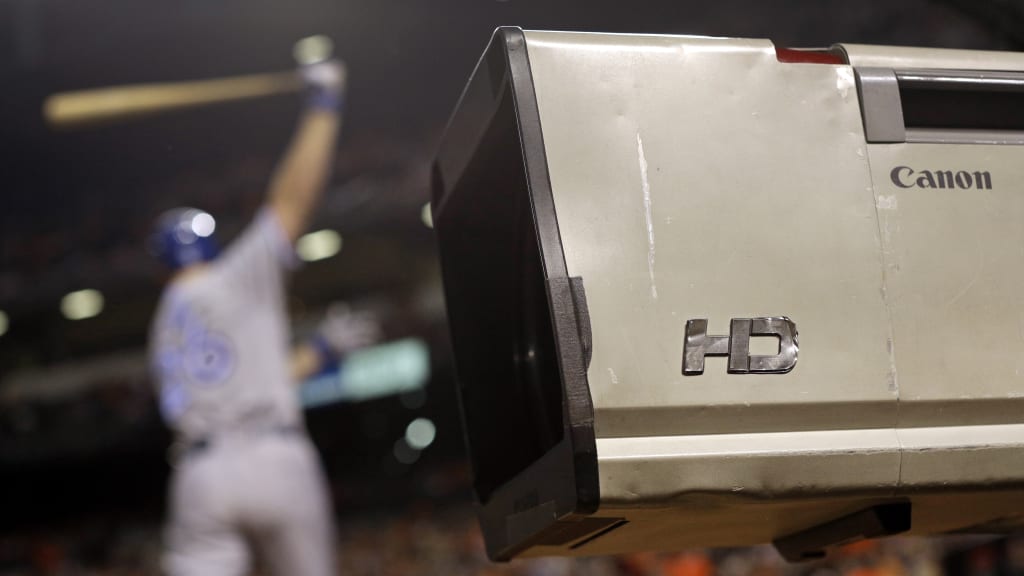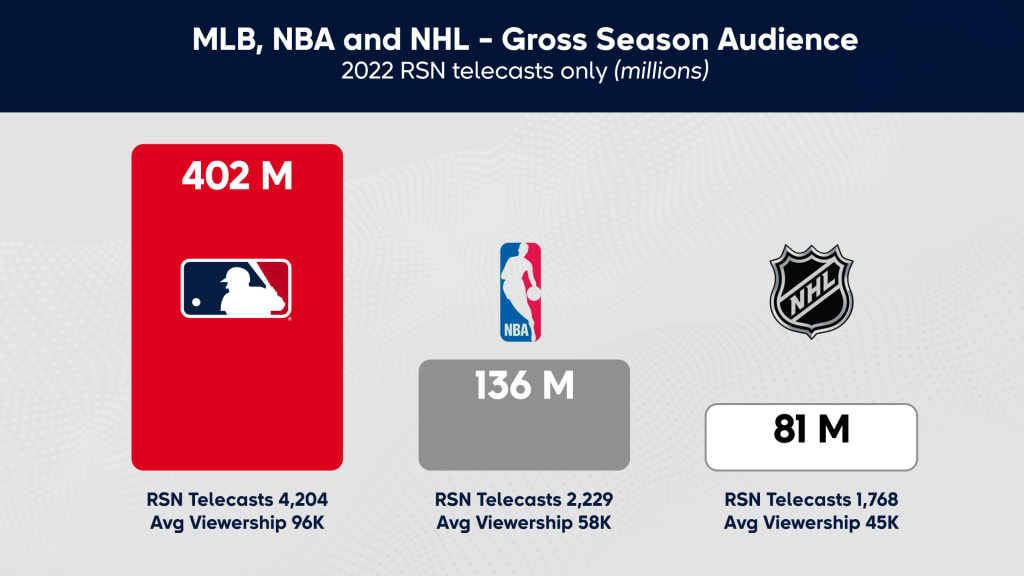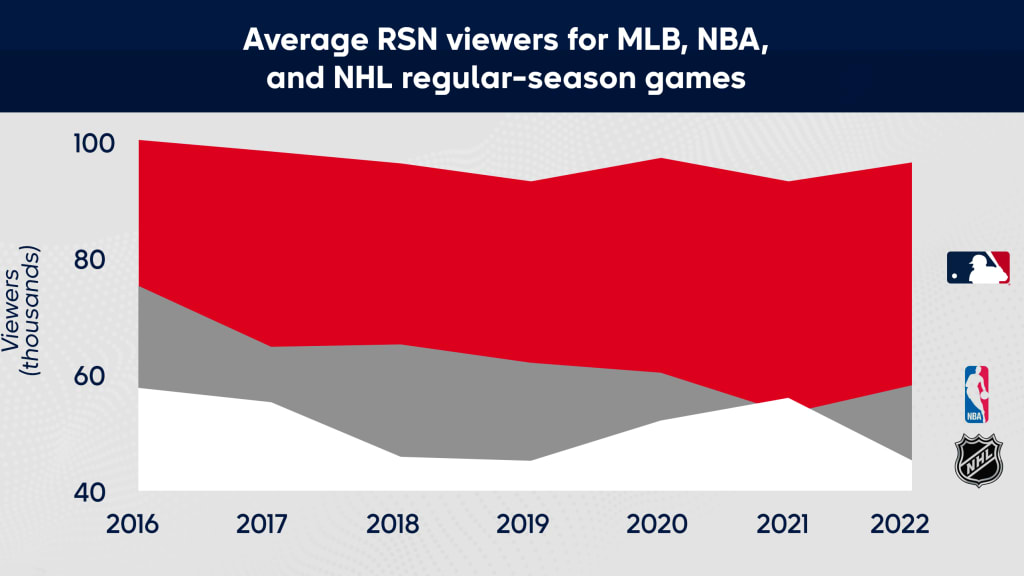
Baseball is the national pastime -- but it's also local.
For the six months of the regular season and the nearly 2,500 games that entails, Major League Baseball is broadcast on the separate regional sports networks that air the games for every team.
As the 2023 season approaches, local television viewership continues to be one of MLB's greatest strengths.
"Why are regional sports networks important, and why are they more important to baseball and why are they successful in baseball?" said Yankees president Randy Levine, who was a principal founder of the YES Network, the most-watched RSN in the U.S. "[Baseball plays] every day. And as a result, people become accustomed to watching their team every day, and the RSN becomes, in effect, an affiliate or an appendage of the team. Fans think of YES, and they think of the Yankees -- as they should."
During the MLB regular season, baseball is the most-viewed local programming. MLB games on the RSNs consistently outperform the top cable primetime programs in their markets, broadcast networks and NBA and NHL teams in shared markets.
That remained true in 2022. Twenty-two of the 29 U.S.-based MLB teams were the top-rated network in their market during primetime regular-season games, when comparing the RSN to all other cable networks.

"Local broadcasts, because we've got so many of them, they're huge for us," said Phillies executive vice president David Buck, who has a decade of experience overseeing the club's broadcasting. "It's all summer, it's very calming and very reassuring. Because it's there every night. It becomes part of people's lives."
In 2022, there were also 13 clubs that didn't just beat all cable programming during their primetime games -- their RSNs also beat all competing primetime programming, period, including the major broadcast networks.

"It's standard," Levine said. "The last couple of years, come the baseball season, when the Yankees game is on, we win the night. Every single night, basically. And we win the week, against all the major networks -- broadcast networks, ABC, NBC, CBS, as well as all the cable networks. We're the No. 1, and have been the No. 1-rated program, in New York for years."
The Cardinals in particular are also a standout team. Their primetime game broadcasts on Bally Sports Midwest averaged a 7.87 rating in the St. Louis market for the 2022 regular season, the highest of any MLB team.
Top MLB RSNs by household rating in 2022
For local primetime games
- Cardinals (Bally Sports Midwest): 7.87
- Padres (Bally Sports San Diego): 5.19
- Brewers (Bally Sports Wisconsin): 5.07
- Phillies (NBC Sports Philadelphia): 4.54
- Astros (AT&T SportsNet Southwest): 4.44
Cardinals games averaged 139% more viewers than the No. 2 channel in primetime during the baseball season -- CBS affiliate KMOV -- according to data provided by Bally Sports Midwest. It was the 13th year in a row that Cardinals baseball was the No. 1 primetime programming in St. Louis.
Teams like the Cardinals dominated the local TV lineup throughout the season. Cardinals games in the summer months of July and August, for example, averaged a 7.90 local rating during primetime, dwarfing the next-most popular cable program, Tucker Carlson Tonight on Fox News, which averaged a 1.89 rating during that same period. Down the stretch -- with the playoff race and Albert Pujols chasing 700 home runs -- the Cardinals closed the season as the No. 1 primetime program in St. Louis on each of the last 36 nights they played on Bally Sports Midwest.
"[Baseball is in] a dominant position for a primetime audience to settle in around an MLB game." said Craig Sloan, chief operating officer of Playfly Sports -- the parent company of Home Team Sports, the sales agency that represents all the MLB RSNs in the U.S. "We're the No. 1 delivery vehicle for ratings in the top [designated market areas] across the country."
Looking at MLB as a whole from April through September, Sloan noted, primetime baseball beats both cable and broadcast networks in the key 18-to-49 adults demographic, a trend that started in 2017.
The top-rated MLB teams in 2022 also included both eventual World Series teams, the Astros and Phillies.
Buck noted that everything a team like the Phillies does on the baseball side, from bringing in star players like Bryce Harper to exciting play on the field like their 2022 pennant run to welcoming franchise legends to the broadcast booth like John Kruk and Mike Schmidt, can set the stage for growth in its local TV audience.
"That builds in the ratings as well," Buck said. "You can just see it growing year to year."
More than half of the MLB clubs in the U.S., 15 of 29 (52%), grew in RSN viewership year-over-year from 2021 to '22, according to the Nielsen data.
Many of the teams with the strongest RSN audience also play in shared markets with an NBA team, NHL team or both. In the majority of those markets, the MLB team earns higher TV ratings for games than basketball and hockey.
Twelve of the 21 MLB teams in shared markets outperformed the NBA and NHL teams in the ratings last season (comparing the 2022 MLB season to those leagues' last completed season, 2021-22).

So the Yankees (3.0 DMA rating overall for the full season) outperformed both the Knicks (0.9), Nets (0.8) and Rangers (0.7) combined, and the Islanders (0.4) and Devils (0.2) combined, in New York. The Dodgers (2.1) outperformed the Lakers (1.5) and Clippers (0.5) combined, and the Kings (0.4) and Ducks (0.2) combined, in L.A. The Phillies (4.2) outperformed the 76ers (3.1) and Flyers (1.6) in Philadelphia.
"Philly is a great sports town," Buck said. "I think baseball has a little wider reach, and therefore that's why the ratings are better than hockey and basketball, at least in Philly.
"What's the phrase -- 'A rising tide lifts all boats'? I think it's better when all the teams are playing well. Because then it's like, 'Oh my gosh, great Phillies season. Now, let's go Eagles, let's go Sixers.'"
When you consider MLB's advantage in the number of games aired over the course of a 162-game season, compared to 82 games for the NBA and NHL, the total TV audience for baseball for a season is much larger than basketball and hockey.

The gross audience for Major League Baseball over the course of a season is unparalleled, with baseball's volume of games and their regularity.
And that 402 million is likely much lower than baseball's true audience. That number includes only the DMA, the core section of the market around the metro area. But MLB games get coverage well into the outer markets, and that audience isn't measured by Nielsen. The true local viewership for an MLB season is estimated to be approximately 50% higher than the calculated numbers.
That audience can make the local MLB broadcasts over the course of a season, across the entirety of MLB, a better indicator of the state of baseball than national playoff broadcasts for short series.
"When you're assessing the total health of the game, you want to look at that sample of 2,500 regular-season games, not a sample of four to seven games where you can't control the matchup," FOX Sports head of strategy and analytics Mike Mulvhill told MLB.com after the Fall Classic. "I think people are understanding that a little bit more every year."
In recent years, MLB teams have regularly averaged about 100,000 viewers for their games on RSNs, including an average viewership of 96,000 for MLB games in 2022. And again, that's only in the DMA. The true audience for a game is significantly larger.

On the average regular season day, 2.3 million fans watch baseball games locally via their RSN. On days where all 30 MLB clubs are playing, the average RSN audience increases to 2.6 million fans.
Baseball's consistency brings in advertisers. Among the largest for MLB in traditional areas, per Playfly, are food and beverage brands like Gatorade, Budweiser and Taco Bell, insurance like Geico and auto companies like Chevrolet. Advertisers with the RSNs are also growing more diversified in areas like technology (including Google), direct-to-consumer brands, travel and tourism and movie studios.
"If you look at the trends over the last couple of decades, the total audience is remarkably consistent," Sloan said. "And no one else in the TV landscape can say that."
Through Home Team Sports, brands can advertise with MLB on an individual RSN (like SNY for the Mets or NESN for the Red Sox), multiple RSNs (like those operated by Bally Sports) or every RSN, because all MLB teams nationwide are in Playfly's portfolio.
In other words: advertisers can buy ad space on the RSNs on a national level, knowing they'll get baseball's devoted local audience in each market.
That's attractive to advertisers and marketers, according to Sloan, because MLB brings the opportunity to reach the largest-scale audience, the most attractive qualitatively (baseball being a brand-safe, family viewing experience, and drawing viewers with disposable income) and one that hits the main target demographic of 18-to-49-year-olds.
"The majority of the advertisers that engage in regional sports networks now are coming in and actually buying the entire country," Sloan said, "and getting all 29 U.S. baseball teams at one time."
If you advertised on the Bally Sports RSNs for the 2022 MLB season, for example, you got a 14-team network umbrella where:
- 1,420 total games -- 58% of all MLB games aired on Bally Sports -- ranked No. 1 in their local market on broadcast, cable or both
- Ten of those 14 MLB teams had at least half their games on Bally Sports rank No. 1 against all other cable programming that day
- At least five Bally Sports MLB games during every week of the regular season ranked No. 1 against all programming that day, broadcast and cable
The value of the RSN in baseball extends beyond the games, too, to shoulder programming like pre- and postgame shows, player human-interest features, Hot Stove content, etc.
"It's a place to not only watch the games, but to get the backstory, to get content, to get information," Levine said. "And because there's so many games, the only entity that's capable of providing that much time, that much space, to accommodate all the content is an RSN."
That includes new forms of content that supplement TV broadcasts, like streaming, direct-to-consumer and in-app experiences. Teams are now allowed to stream local games in local markets, which also allows RSNs to expand their apps. Playfly's research has found this only adds to the number of fans consuming baseball content for their favorite teams, with "no degradation" to the TV audience.
"The amount of content is really incredible, because it's essentially a four-hour evening -- pregame, in-game and postgame on these regional sports networks," Sloan said. "The duration and the amount of time spent is an incredible stat: More people will watch Major League Baseball over the course of the six months of the season than will watch the top 20 programs on broadcast or cable combined."
"There are all different ways of getting the content out there now," Buck said. "Things have changed a lot in [the last] five years; they'll change a lot more in [the next] five years. But I think it's all positive. Watching your local team will always be a huge deal, especially for baseball teams. And I don't see that changing even a little bit."
